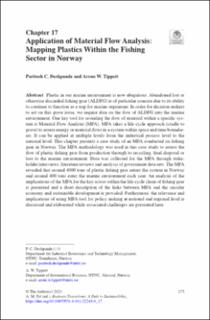| dc.contributor.author | Deshpande, Paritosh Chakor | |
| dc.contributor.author | Tippett, Arron Wilde | |
| dc.date.accessioned | 2024-02-21T12:17:53Z | |
| dc.date.available | 2024-02-21T12:17:53Z | |
| dc.date.created | 2023-02-23T12:26:03Z | |
| dc.date.issued | 2023 | |
| dc.identifier.isbn | 978-3-031-22244-3 | |
| dc.identifier.uri | https://hdl.handle.net/11250/3119015 | |
| dc.description.abstract | Plastic in our marine environment is now ubiquitous. Abandoned lost or otherwise discarded fishing gear (ALDFG) is of particular concern due to its ability to continue to function as a trap for marine organisms. In order for decision makers to act on this grave issue, we require data on the flow of ALDFG into the marine environment. One key tool for revealing the flow of material within a specific system is Material Flow Analysis (MFA). MFA takes a life cycle approach (cradle to grave) to assess energy or material flows in a system within space and time boundaries. It can be applied at multiple levels from the industrial process level to the national level. This chapter presents a case study of an MFA conducted on fishing gear in Norway. The MFA methodology was used in this case study to assess the flow of plastic fishing gear from production through to recycling, final disposal or loss to the marine environment. Data was collected for the MFA through stakeholder interviews, literature reviews and analysis of government data sets. The MFA revealed that around 4000 tons of plastic fishing gear enters the system in Norway and around 400 tons enter the marine environment each year. An analysis of the implications of the MFA for the key actors within the life cycle chain of fishing gear is presented and a short description of the links between MFA and the circular economy and sustainable development is provided. Furthermore, the relevance and implications of using MFA tool for policy making at national and regional level is discussed and elaborated while associated challenges are presented here. | en_US |
| dc.language.iso | eng | en_US |
| dc.publisher | Springer | en_US |
| dc.relation.ispartof | Business Transitions: A Path to Sustainability. The CapSEM Model | |
| dc.rights | Navngivelse 4.0 Internasjonal | * |
| dc.rights.uri | http://creativecommons.org/licenses/by/4.0/deed.no | * |
| dc.title | Application of Material Flow Analysis: Mapping Plastics Within the Fishing Sector in Norway | en_US |
| dc.title.alternative | Application of Material Flow Analysis: Mapping Plastics Within the Fishing Sector in Norway | en_US |
| dc.type | Chapter | en_US |
| dc.description.version | publishedVersion | en_US |
| dc.source.pagenumber | 175-183 | en_US |
| dc.identifier.doi | 10.1007/978-3-031-22245-0_17 | |
| dc.identifier.cristin | 2128545 | |
| cristin.ispublished | true | |
| cristin.fulltext | original | |
| cristin.qualitycode | 1 | |

